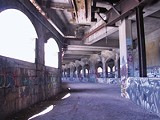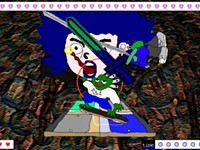Fiz 5.25.05
Forgive their trespasses | Push it real good
[
{
"name": "500x250 Ad",
"insertPoint": "5",
"component": "15667920",
"parentWrapperClass": "",
"requiredCountToDisplay": "1"
}
]
Forgive their trespasses
Plans to fill in the abandoned Rochester subway tunnels is not only causing a stir in the community of homeless folks who find shelter there --- it's also sending ripples through the urban exploration community.
The Rochester subway is a favored spot among urban explorers probably because it's relatively easy to get into, and the landscapes are so rich once you're there. Rochester subway photos are posted on several websites either devoted entirely (www.infiltration.org, www.uer.ca --- both covering North America) or partially (rocwiki.org --- local info of all kinds) to the art of urban exploration. Another local hotspot? The Rochester Psychiatric Center, for all its creepy, highly guarded glory.
Urban explorers are trespassers, essentially, so let's keep it quiet, shall we? Websites devoted to the hobby provide information from ethics to safety (get your tetanus shots; test floors before walking on them) to security to interesting sites ripe for exploration. No real names are used, but you start to follow posters' identities and learn pretty quickly who is willing to go where.
This is not vandalism; it's voyeurism. It's a thrill to get into an abandoned hospital, sure. But these monuments to lost industry, closed business, and past worship, are treated with reverence --- as if they were the ruins of an ancient civilization.
See what's left inside the Bee Bee Power Plant, the Delco Plant, the old church in Mt. Hope Cemetery, the underground tunnels. EvilNick, an avid poster on www.uer.ca, took a haunting photo at Bee Bee of a worker's abandoned desk --- prom photos, a business card, and a tie clutter the desktop. Why do so many of these scenes give you a Pompei-like feeling? These intrepid infiltrators are snatching moments, oddly recognizable but still so creepily removed from us, of our history. And all we have to do is log on.
As Ninjalicious says on www.infiltration.org: "I find it sad that most people go through life oblivious to the countless --- free --- wonders around them."
--- Erica Curtis
Push it real good
On the cusp of summer, prepare yourself to be assaulted by a battery of dragon-like lawnmowers shearing your neighbors' grass to an unnatural buzz at ungodly morning hours. Landscape hygiene has come to a screaming pitch in urban and suburban areas, mostly to the detriment of your peace and quiet. Especially in the city, with houses set as close as they are, it's impossible to ignore the John Deere thrashing about the carpet-sized yard next door.
Thankfully, "push mowers" or "reel" mowers are experiencing a mild resurgence in landscape culture. For the uninitiated, a push mower is the original version of the lawn mower. They have exposed, parallel blades and run by manual power. Although we see them now as old-fashioned, they have a much more modern sensibility than gas-powered mowers.
The reasons are simple: Push mowers are environmentally friendly. Gas-powered mowers have never had the same emission-control policies as cars, and, according to Canada's Clean Air Consumer Guide, "In one hour of operation, a conventional gas lawnmower pollutes as much as 40 new cars." And because they don't require gas, push mowers are much more inexpensive to run. They are also cheaper to buy. Prices range from $90 to $200.
They do have their disadvantages: Lawns must be maintained on a weekly basis. And push mowers can't cut tall weeds. They also require more effort to operate, but hey, you can think of it as lawn yoga. As one customer on the Clean Air Gardening website recently put it, "Best of all, it is quiet. It made a soft clicking sound as I mowed, allowing me to hear the evening calls of the songbirds."
--- Michael Neault



